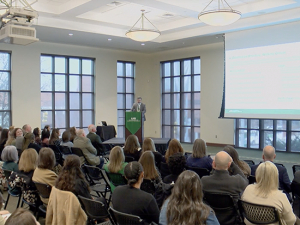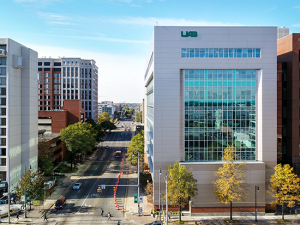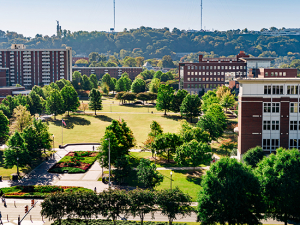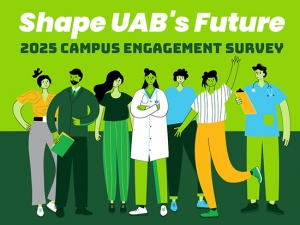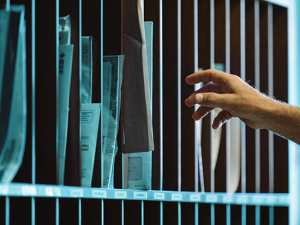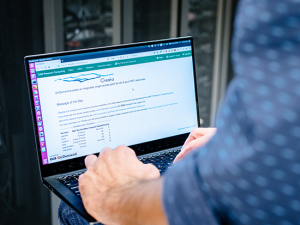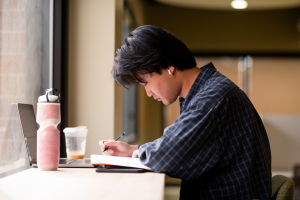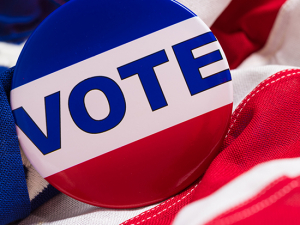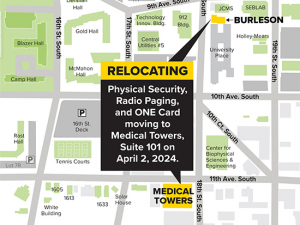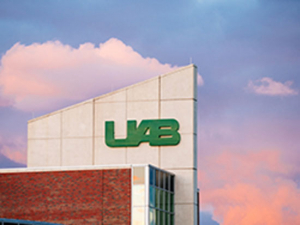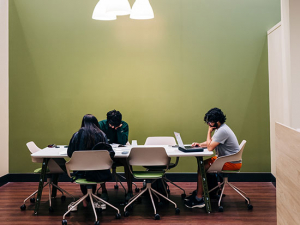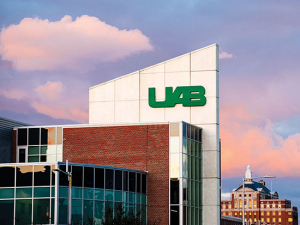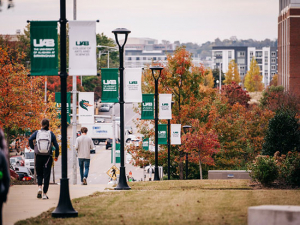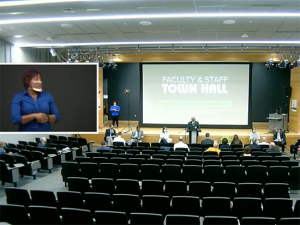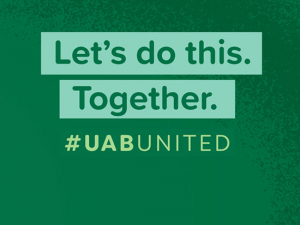 In a virtual town hall July 8, President Ray Watts, Provost Pam Benoit and other senior leaders provided updates and answered questions on planning for the re-entry to campus for Fall 2020 (watch the full video here).
In a virtual town hall July 8, President Ray Watts, Provost Pam Benoit and other senior leaders provided updates and answered questions on planning for the re-entry to campus for Fall 2020 (watch the full video here).
Faculty submitted more than 160 questions and comments during the hour-long event. Many were answered in the town hall and these were included in the comprehensive wrap-up that the Reporter published the following day. Here are answers to the rest of the questions received.
Scroll down to read the complete summary or use the links below to jump to specific topics
Re-entry procedures and decisions
COVID precautions and procedures in the classroom
COVID testing, tracing and Healthcheck
Faculty policies and accommodations
Other student experience questions
Re-entry procedures and decisions
Is the need for on-campus learning experiences more pressing than population health? Were students ever questioned as to which they would prefer?
More faculty questions answeredRead a summary of comments and answers shared by UAB leaders during the Faculty Town Hall on July 8, or watch the entire event here. |
The University of Alabama System has directed that all three system campuses be open for on-campus classes in the fall, subject to social-distancing requirements. Our class design for the fall was developed with recommendations from our health experts, and we will be constantly monitoring population health through our Healthcheck technology and student and sentinel testing data.
Additionally, an Incident Command team is carefully monitoring health data to make determinations on any changes that need to be made to course delivery. While UAB did not take a survey of students, there are surveys from other comparable institutions showing that a majority of students favor returning to campus, in a safe manner.
Don't the CDC guidelines suggest that case numbers need to have been declining for two weeks in order to follow reopening procedures?
This is a fluid situation. While circumstances may change for the better or worse in the coming weeks, it is our duty to plan as thoughtfully as possible for a safe on-campus environment this fall. We are putting extensive strategies in place to minimize risk, and we will continue to closely monitor the global and local effects of the pandemic and make informed, evidence-based decisions.
Harvard has announced that it is not holding any in-person classes, citing the lack of available resources to make it safe. Does UAB have more resources than Harvard? Or does leadership disagree that classrooms can’t be made safe?
We believe the combination of technology, safety procedures and resources we are putting in place to minimize risk can facilitate safe in-person instruction. We will continue to closely monitor the global and local effects of the pandemic and make informed, evidence-based decisions.
If COVID numbers are still trending in August the same way they are presently, could/would the particulars of reopening UAB be revisited or amended?
A UAB Incident Command team is carefully monitoring health data to make determinations on any changes that need to be made to course delivery and campus density. The team is prepared to quickly deliver recommendations to senior leadership for any changes that might need to be made.
Will the university be trying to use results of simulations like those done elsewhere to estimate the spread of the coronavirus under various degrees of student, faculty and staff compliance?
Experts from the School of Public Health are providing modeling that is helping UAB leadership in any changes needed to operations.
Will the underlying data used to develop the color-coding system be made available (i.e. the trending numbers of new COVID-19 cases in our community, our testing capability, etc.)?
We are developing a dashboard that provides information on campus and community health.
How do we reconcile the failure to comply with the basic precautions in the Alabama community and the expectation of compliance by our students from the Alabama community?
UAB can reduce risk on campus because of a concerted public health communications effort and more control of the ability to educate, monitor and mandate safety requirements.
At the last town hall, President Watts, in response to a question about campus autonomy, suggested that each campus in the UA system, given the differences, would have to make their own decisions about how to proceed safely. It now seems that the UA System Board is making the decisions for all campuses after all. Is this a change from the last town hall?
UAB has worked in partnership and with the support of the UA System throughout this pandemic, and UAB has provided key leadership roles in task forces providing infectious disease, public health and other expertise to system reentry efforts. There are many similarities in re-entry plans, best practices and strategies as we leverage the strength of our system, but there are also ways in which UAB's plans and logistics may differ from our sister campuses based on our unique campus.
Is there any concern about liability? For example, if a student claims to have gotten COVID-19 from a class or UAB?
Before returning to campus, students will provide an attestation that (1) they understand the risks associated with returning to campus; (2) they confirm they completed a required COVID-19 safety training and awareness course; and (3) they intend to follow all required health and safety guidelines.
[back to topic list]
COVID precautions and procedures in the classroom
Attendance
Are students permitted to miss or delay assignments and tests due to a positive COVID-19 test, even if they may be asymptomatic?
If students test positive for COVID-19 they need to quarantine for two weeks and not report to the classroom for any in-person class sessions to which they are assigned. As with any student health situation, faculty should be flexible in allowing alternatives to delivering the in-class content and in allowing make-up opportunities. If students can complete assignments, they can continue with any remote portions of their classes. Instructors are encouraged to be flexible and use remote-learning when possible. Instructors can refer students to Disability Support Services if a temporary academic adjustment is needed.
If students assigned to attend on-campus attend online instead, is that counted as being absent for the class?
Attendance policies should be the same as pre-COVID. Not all instructors have mandatory attendance. Instructors are encouraged to be flexible and use remote-learning when possible. Instructors can refer students to Disability Support Services if a temporary academic adjustment is needed.
Will UAB provide an easy way for students to get tested if they feel sick in order to justify potential absences to class? I am assuming students won't take advantage of a pandemic to skip class, but as professors, we also need to be very clear about the requirements to pass a course.
Testing through Student Health will be completely accessible. Attendance policies should be the same as pre-COVID. Not all instructors have mandatory attendance. However, Disability Support Services may be necessary if a student’s condition warrants longer term adjustments.
[back to topic list]
Cleaning
Will any additional time be given between classes to account for the self-cleaning faculty and students are expected to do, or do we need to factor that into in-person class times? Can you tell us what cleaning is required?
No additional time has been added between classes. See this question in the Fall 2020 Faculty FAQs: “What are we going to do about students arriving late for class due to elevator and other traffic flow restrictions?”
Have UAB buildings/HVAC systems been examined for adequate air exchange to avoid aerosol transmission of the virus?
The filtering used in our HVAC systems are already the highest quality that can be used. We are closely monitoring the most recent data and adapting our operations, based on the current guidance available (CDC; American Society of Heating, Refrigerating and Air-Conditioning Engineers; etc.). If new information regarding these systems is provided through the CDC, we will address it quickly. If you have a specific area of concern, please contact Environmental Health and Safety at ehssafety@uab.edu.
[back to topic list]
Masks
I've heard a rumor that we will be wearing face shields, not masks when teaching classes. Is this correct?
You are required to wear a face covering. We will provide face shields in addition to masks to faculty in the case they would like to wear one. Some students rely on lip-reading; if a student provides a DSS accommodation letter which states this accommodation, it is recommended that you wear the face shield for that class. Questions about this accommodation should be directed to Disability Support Services.
If a student has a health reason that would prohibit wearing a mask will they be required to go through DSS for verification? What's the threshold for reporting students to student conduct for not wearing masks? Are you saying that even if they comply (once asked), that they are still to be reported?
Yes, the student would need to work with Disability Support Services on remote-learning adjustments. Guidance on responding to students who do not comply is available in the Fall 2020 Faculty FAQs.
Will there be stations or areas in each building where a student can get a mask and practice other sanitation procedures? You said you are giving us two masks to give to students if necessary but I can only imagine that those would be given out early in the semester and more may be needed.
Faculty will be equipped with additional face coverings for students and sanitizer stations will be in the buildings.
[back to topic list]
Social distancing
How will we ensure students maintain social distance in classes or when they are walking in halls, etc.?
All students are required to take training on proper social-distancing before returning to classes. Density in buildings will be reduced due to our hybrid teaching model. We are adding extensive signage to classrooms and public spaces in classroom buildings.
Are faculty allowed to meet students on campus at this time if social distancing practices are observed?
Only if both parties have taken the training and completed their Healthcheck.
What if my class is being offered in a classroom that can’t accommodate social-distancing given the current enrollment?
All faculty being asked to teach in person will be given class space that provides for proper social distancing as required by the university.
I'm concerned that department chairs rather than people with public health training are being put in charge of assessing the amount of space available in classrooms with social-distancing. Can we trust the classroom space assessments?
Chairs will get their plans approved and are using information from UAB health experts on developing plans.
[back to topic list]
Teaching outdoors
Currently, it appears that most coronavirus transmission happens indoors because air moves around more freely outdoors. Is UAB considering facilitating holding some classes outdoors when weather permits?
Several departments are working on providing the opportunity for certain classes to be held outside. If you are interested in this option, please let your chair know. We cannot guarantee making this option available for all classes.
Could we get some outdoor shade tents for meetings? I plan to meet my new graduate students in the fall for an outside meeting (with masks) and am already scoping shady areas where we can distance in shade.
Please communicate with your chair on the potential for hosting outdoor classes.
[back to topic list]
Technology
Teaching in Heritage Hall, I have often had problems with the audiovisual equipment. What happens if the camera — which is supposed to transmit the class to students, who are not supposed to attend that day — does not work?
UAB IT has spent this summer working on ensuring good technology in the classrooms. There will be technicians available during class times to troubleshoot. Instructions will be placed in classrooms for how to contact them.
What happens if the video equipment is not available in time for the fall semester?
UAB IT is ensuring all necessary video equipment is ready.
Can each instructor use a personal microphone so that he or she doesn’t have to speak out loud, sprinkling droplets, when giving a lecture?
Yes.
I am teaching a course this summer. As we upload the video recordings of our lectures to Canvas, we are running out of the allocated space to courses. Could we increase the space quota associated with each class?
Kaltura is the recommended platform for uploading videos and making them available in Canvas. Through Kaltura, users have access to tools such as screen recordings, editing, automatic upload and cloud encoding of their multimedia materials for device-agnostic delivery. The media can be inserted into the courses via an embed feature that is integrated into the content editor in Canvas. Kaltura offers unlimited storage space as opposed to Canvas. For tutorials and guides, please visit the Kaltura webpage on the eLearning website.
Does the hybrid instruction model include providing faculty with two-in-one laptops? This will enable real-time problem-solving directly on the auditorium screen for students in class and via Zoom for online students.
Please work with eLearning to determine if you need technology updates to conduct your classes.
[back to topic list]
COVID testing, tracing and Healthcheck
Since the cases continue to rise in Jefferson County, will employees be required to be tested before re-entry and will the testing be paid by your individual insurance?
Currently, employees are encouraged to participate in the sentinel testing program and are required to complete their Healthcheck.
| This information is accurate as of publication. For the latest information on testing procedures and protocols, visit the uab.edu/coronavirus site here. |
Will the current level of positive tests be communicated to faculty in real-time?
We are developing a dashboard that provides information on campus and community health.
Will staff and students be required to complete the self-check and keep it updated? This seems like a privacy issue.
They will be required to complete their Healthcheck, which has been designed to comply with privacy rules.
Will adjuncts also need to sign up and comply with Healthcheck?
Yes.
It sounds like UAB’s ability to respond effectively to positive cases depends entirely on individuals participating in the tracker app. Since this is voluntary, what happens with positive cases of individuals who don’t participate in that app?
The Exposure Notification App is an additional tool to traditional contact tracing and the work of public health officials and Employee Health. The app enhances and speeds up exposure notification.
What is the basis for using a 15-minute threshold for defining contact [in the Exposure Notification App]?
This is based on CDC guidance.
I would like more transparency in how the contact tracing and building cleaning works. How is contact tracing done? Through interview and who that person remembers seeing over the last several days or people that have access and work in that same area? Can we learn what day the infected person was last on campus? How long between when the person has symptoms and they are tested, get their results, and others are notified about the potential exposure? How soon after the report is the building cleaned?
For information on reporting symptoms and exposures to Employee Health, see these comments from Employee Health Medical Director Sarah Nafziger, M.D., from the town hall.
UAB also will be using the Stay Safe Together Exposure Notification App to alert individuals to possible exposures. Information on the program is being shared here as it is developed and available.
For more information on cleaning protocols followed by UAB Facilities after notification of a confirmed case of COVID-19 on campus, see the second page of Facilities’ Enhanced Cleaning and Disinfection Protocols document.
[back to topic list]
Faculty policies and accommodations
What would be a reasonable accommodation on which a chair and faculty member could agree if an educator is in a CDC-defined, high-risk COVID-19 category?
The interactive dialogue between instructors and faculty should help to identify reasonable accommodations. As stated in the Fall 2020 Faculty FAQs, if an instructor’s assigned teaching includes in-person classes and yet the instructor is fearful of teaching an in-person class in fall 2020, then they should work with the chair of their department to explore teaching modality solutions that recognize the importance of academic and pedagogical needs while attempting to align needs with faculty preference.
What happens if a faculty finds out they are pregnant in the middle of the semester? Pregnant women are considered an at-risk population.
Faculty should consult with the AWARE program in a situation like this, as described in the Fall 2020 Faculty FAQs – “If I, or someone I live with, is at high risk for COVID-19 based on the Center for Disease Control’s criteria, do I have to teach in-person in fall 2020?”
Will catching COVID-19 be considered a work-related medical emergency for professors who must teach in-class courses?
See this question in the Fall 2020 Faculty FAQs: “What should I do with my class if I get sick with COVID-19 or must self-quarantine and am unable to continue teaching (either in-person or remotely)?”
Can we decide if we want to change our in-person class to remote? Who makes the final decision? Faculty are meant to work with their chairs for accommodations. What flexibility do chairs have for moving courses to remote only?
Whether and how much faculty will need to be on campus for in-person instruction times for hybrid courses will be determined on a case-by-case basis in an interactive dialogue with chairs or other supervisors. See the Fall 2020 Faculty FAQs on the UAB Re-entry webpage.
Some departments make extensive use of graduate teaching assistants to teach low-level undergraduate classes. Presumably the GTAs so involved will have the same access to assistance (CTL, etc.) as regular faculty and part-time faculty.
Yes.
What about faculty who have child-care needs given that many of the schools are planning to continue remote instruction in the fall?
Please visit here to learn more about child-care resources.
Since the fall semester will consist of a hybrid schedule, will faculty still be allowed to work remotely as long as job duties/obligations are met?
Whether and how much faculty will need to be on campus for in-person instruction times for hybrid courses will be determined on a case by case basis in an interactive dialogue with chairs or other supervisors. See the Fall 2020 Faculty FAQs on the UAB Re-entry webpage.
If the COVID-19 pandemic extends way beyond 2021 will UAB grant another grace period for tenure-track professors to be able to publish what is required, or it will be a one-year grace period only?
We will keep faculty updated on the tenure-clock extension as the effects of the pandemic continue to be felt.
How long will it take to process AWARE requests?
Accommodation requests are unique and specific to the individual employee. Any request for an accommodation as part of UAB’s re-entry process through the AWARE program will be reviewed and processed as quickly as possible. Requests are reviewed and processed in the order in which they are received.
Why are faculty in the SOM without a clinical appointment exempt from the FFCRA, and only offered unpaid leave? Can cases be reviewed individually?
The decisions on the availability of the paid sick leave provided under the Families First Coronavirus Response Act were made shortly after that law took effect in April 2020. There are a variety of leave types that might be available to employees. Please address your questions to leave@uab.edu.
[back to topic list]
Hybrid instruction
What is the operational definition for hybrid instruction? Are there minimum requirements for in-person meetings? Are there requirements for synchronous vs. asynchronous class meetings if you are teaching hybrid?
Please visit the Fall 2020 Faculty FAQs to learn more about our hybrid learning model.
When will the schools be able to make the needed changes to the fall schedule so that faculty can better plan for their classes — whether they are face-to-face, hybrid, remote? The uncertainty is adding even more stress for faculty.
We are actively working to get this information published as soon as possible.
It was a struggle to change to remote delivery of course lectures this spring. What back up plans are in place if we have to lockdown again due to COVID? What can instructors be doing just in case?
We are appreciative of the changes faculty made so quickly to ensure course delivery in the spring. The hybrid learning model is designed so that there can be switches between remote and in-person teaching modalities. Throughout the spring and summer, the eLearning team has provided training and resources to faculty to assist them in all remote-learning options. Those workshops are ongoing and we encourage faculty to participate. See the questions about resources in the Fall 2020 Faculty FAQs.
Are the cohorts [for assigning classes] undergrad only, or does it include grad?
Undergraduate and graduate.
If a class can be taught totally online, would a face-to-face (hybrid) class still be recommended/required?
The only fully online classes are those already designated as such (Q) in the course catalog. However, the pedagogical best practices for the remote aspects of the hybrid model would also benefit either fully remote or fully online classes. Please use the resources of the Center for Teaching and Learning and the Division of eLearning described in the Fall 2020 Faculty FAQs.
[back to topic list]
Research questions
Undergraduate students are beginning to inquire about fall research. In some cases, research is required for their degree and/or honors program and/or deptartment honors. Some have already been trained, but some have not been.
For lab research, rules for student participation are set by the Office of the Vice President for Research. Chairs and faculty should periodically check this webpage for updates. Untrained undergraduate students will likely not have lab component requirements this semester.
For undergraduates who want to sign up for a course that normally requires faculty mentor-directed laboratory-based research, how will this be handled for the fall semester given COVID restrictions?
For lab research, rules for student participation are set by the Office of the Vice President for Research. Chairs and faculty should periodically check this webpage for updates.
Keeping the doors to the research buildings locked is very disruptive to the operation of the cores. Can we please unlock the research labs or, at the very least, make sure everyone who has a OneCard has access to the buildings?
Questions about access to research buildings should be directed to the Office of the Vice President for Research. See their reentry website here.
[back to topic list]
Other student-experience questions
Will there be student shadowing opportunities for clinical students this fall?
These will be developed at the school or department levels.
Do we know when embassies will open for visa applications for graduate students?
The teams at INTO UAB and International Student and Scholar Services have compiled the following FAQ sheet for international students. See page 4, question 15, for a detailed answer to this question.
Can each instructor get the information about which students are living at the dorm or commuting from home? Such information will enable us to plan ahead for students who may choose to stay on campus for online classes.
There is not a feasible way to let instructors know students’ living situations. If a given course might require the instructor to know this information, the instructor should communicate directly with students.
Will students be able to attend all of their classes remotely? Many out of state/country students are asking this questions. Most of my students are taking lab sciences as well and this is a major concern. I would like to know how to advise them. Thank you!
The students are getting information regarding the teaching mode for their assigned classes, and we will continue to update them through town halls and other modes of communication. As always, there is a selection of online-only courses (“Q”). Not all classes are fully online and for those that are not, students are expected to be on campus for in-person portions of remote learning, just as was the case for face-to-face courses pre-COVID. Faculty should work with chairs on developing lab times for students while ensuring social distancing requirements.
[back to topic list]
